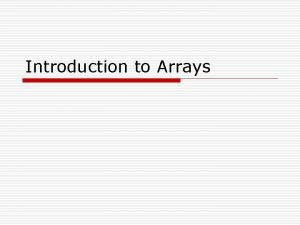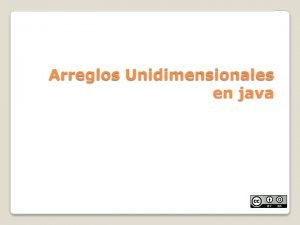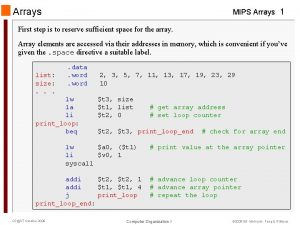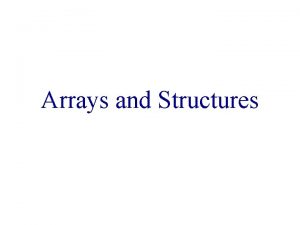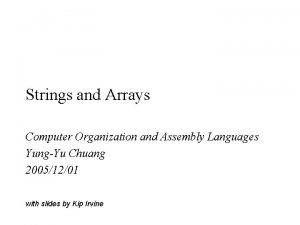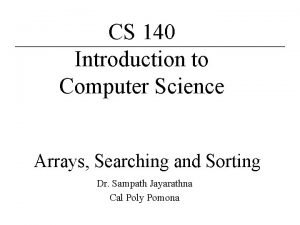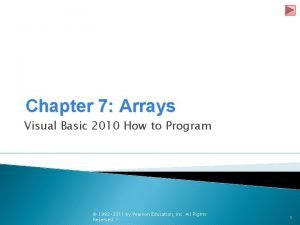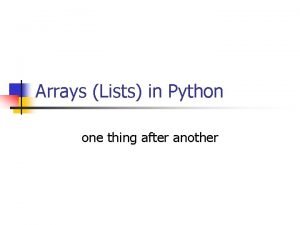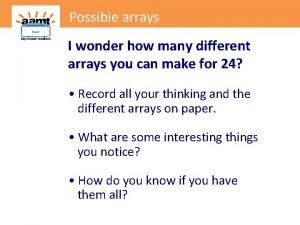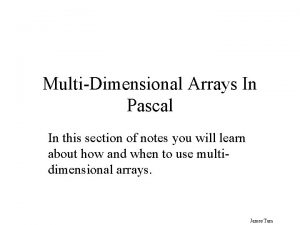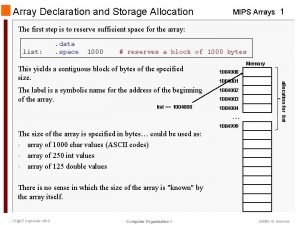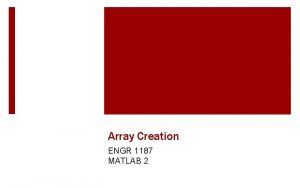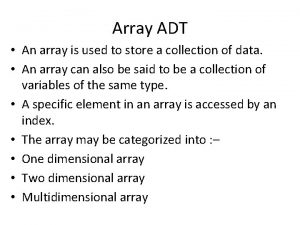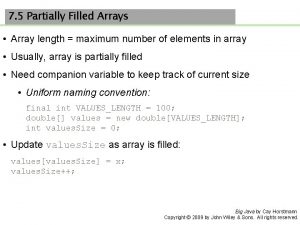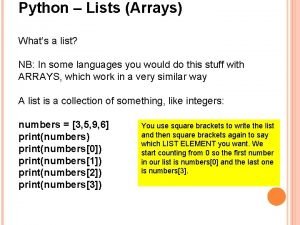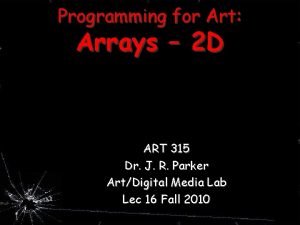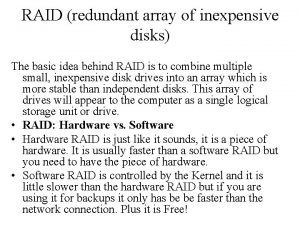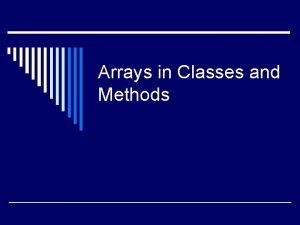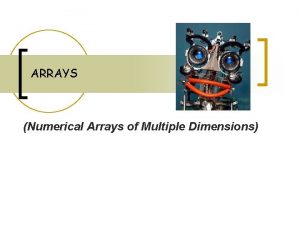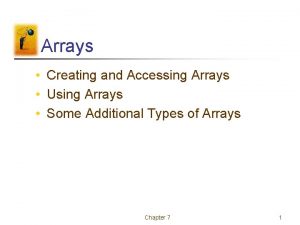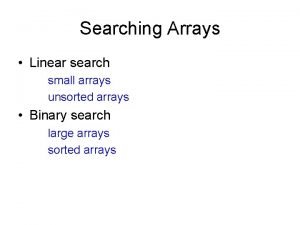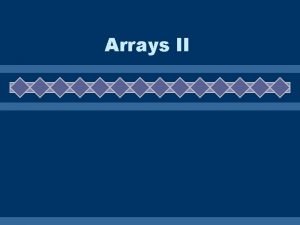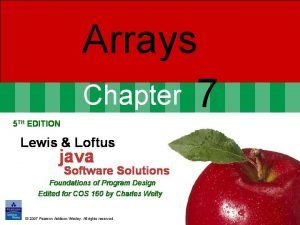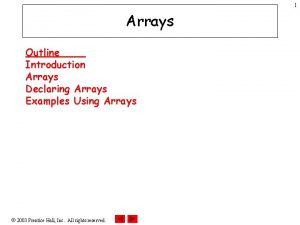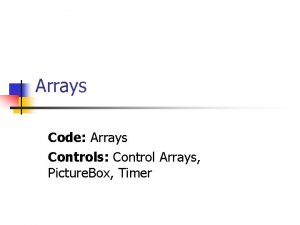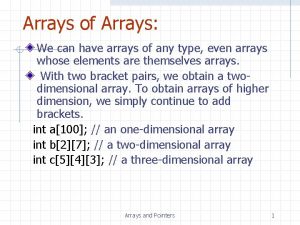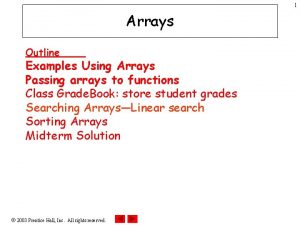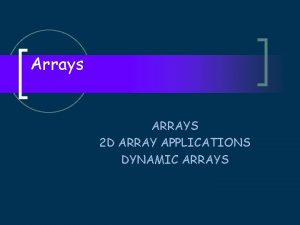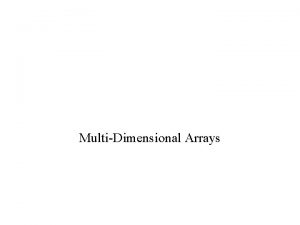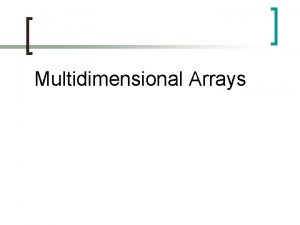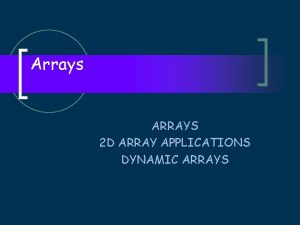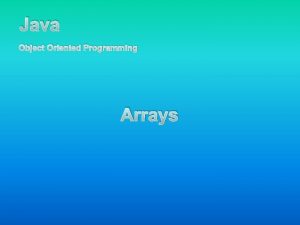EEE 145 ARRAYS Motivation You may need to









![Arrays • The index must of int type. int k[5]; k[k[4]/k[1]]=2; /* Correct as Arrays • The index must of int type. int k[5]; k[k[4]/k[1]]=2; /* Correct as](https://slidetodoc.com/presentation_image_h2/2ff4ed4d84040f21caa904474878edbe/image-10.jpg)
![Arrays • The lower bound must be nonnegative. float m[8]; int i; m[-2] = Arrays • The lower bound must be nonnegative. float m[8]; int i; m[-2] =](https://slidetodoc.com/presentation_image_h2/2ff4ed4d84040f21caa904474878edbe/image-11.jpg)

![Initializing Arrays • You may initialize an array during definition as follows: int array[5] Initializing Arrays • You may initialize an array during definition as follows: int array[5]](https://slidetodoc.com/presentation_image_h2/2ff4ed4d84040f21caa904474878edbe/image-13.jpg)










![Example #8 • Write a function that inverts its array parameter. void invert(int ar[10]) Example #8 • Write a function that inverts its array parameter. void invert(int ar[10])](https://slidetodoc.com/presentation_image_h2/2ff4ed4d84040f21caa904474878edbe/image-24.jpg)







![Example #3 int flat[10][5], i, j, sum=0; float avg; for (i=0; i<10; i++) for Example #3 int flat[10][5], i, j, sum=0; float avg; for (i=0; i<10; i++) for](https://slidetodoc.com/presentation_image_h2/2ff4ed4d84040f21caa904474878edbe/image-32.jpg)

![Example #4 #define ABS(x) ((x)<0) ? -(x) : (x) int map[1000], int coord_x, coord_y, Example #4 #define ABS(x) ((x)<0) ? -(x) : (x) int map[1000], int coord_x, coord_y,](https://slidetodoc.com/presentation_image_h2/2ff4ed4d84040f21caa904474878edbe/image-34.jpg)




- Slides: 38

EEE 145 ARRAYS

Motivation • You may need to define many variables of the same type. – Defining so many variables one by one is cumbersome. • Probably you would like to execute similar statements on these variables. – You wouldn't want to write the same statements over and over for each variable. 1

Example #1 • Write a program that reads the grades of 300 students in EEE 145 and finds the average. 2

Example #1 (cont'd) • Soln: #include <iostream> using namespace std; int main() { int i, sum=0, grade; float avg; } for (i=0; i<300; i++) This was simple. { cin>>grade; Since we don't need to store all values, taking the sum is enough. sum += grade; So, we don't need an array. } avg = sum/300. 0; cout<<"Average = " <<avg<<endl; return 0; 3

Example #2 • Write a program that reads the grades of 300 students in EEE 145 and finds those that are below the average. 4

Example #2 (cont'd) • Soln #1: #include <iosteam> using namespace std; int main() { int i, sum=0, grade; float avg; } for (i=0; i<300; i++) { cin>>grade; sum += grade; WRONG! } "grade" contains the score of the avg = sum/300. 0; last student. for (i=0; i<300; i++) You have already lost the if (grade<avg) previous 299 scores. cout<<"Below avg: " <<grade<<endl; return 0; 5

Example #2 • (cont'd) Soln #2: #include <iostream> using namespace std; int main() { int i, sum, gr 0, gr 1, gr 2, . . . , gr 349; float avg; cin>>gr 0; cin>>gr 1; cin>>gr 2; . . . You cannot skip these with ". . . " You have to repeat each of these statements 300 times. sum = gr 0+gr 1+gr 2+. . . +gr 349; avg = sum/300. 0; if (gr 0<ave) cout<<"Below avg: " << gr 0 << endl; if (gr 1<ave) cout<<"Below avg: " << gr 1 << endl; if (gr 2<ave) cout<<"Below avg: " << gr 2 << endl; What is still wrong here? . . . if (gr 299<ave) cout<<"Below avg: " << gr 299 << endl; return 0; } 6

Example #2 • Soln #3: (cont'd) Defines an array consisting of 350 integer values. In the definition, the value in the brackets is the number of elements (size). #include <iostream> using namespace std; int main() { int i, sum=0, grade[300]; float avg; This means the ith element of the array. Here, the value in the brackets is the index, not the size. } for (i=0; i<300; i++) { cin >> grade[i]; sum += grade[i]; } avg = sum/300. 0; for (i=0; i<300; i++) if (grade[i]<avg) cout<<"Below avg: "<<grade[i]<<endl; return 0; 7

Arrays • An array is a variable that is a collection of multiple values of the same type. • Syntax: type array_name[int_constant_value]={initializer_list}; • The size has to be of int type and must be a fixed value (i. e. , known at compile time). • You can define an array of any type (eg: int, float, enum student_type, etc. ) • All elements of the array have the same type. • You cannot use the {} format for initialization after variable definition, ie, int a[3]={5, 8, 2} is correct, but int a[3]; . . . a={5, 8, 2} is wrong. 8
![Arrays The index must of int type int k5 kk4k12 Correct as Arrays • The index must of int type. int k[5]; k[k[4]/k[1]]=2; /* Correct as](https://slidetodoc.com/presentation_image_h2/2ff4ed4d84040f21caa904474878edbe/image-10.jpg)
Arrays • The index must of int type. int k[5]; k[k[4]/k[1]]=2; /* Correct as long as k[4]/k[1] is nonnegative*/ k[1. 5] = 3; /* Error since 1. 5 is not int */ 9
![Arrays The lower bound must be nonnegative float m8 int i m2 Arrays • The lower bound must be nonnegative. float m[8]; int i; m[-2] =](https://slidetodoc.com/presentation_image_h2/2ff4ed4d84040f21caa904474878edbe/image-11.jpg)
Arrays • The lower bound must be nonnegative. float m[8]; int i; m[-2] = 9. 2; /* Syntax error */ i=-2; m[i] = 9. 2; /* Run-time error */ 10

Initializing Arrays • The elements of a local array are arbitrary (as all other local variables). • The elements of a global array are initialized to zero by default (as all other global variables). 11
![Initializing Arrays You may initialize an array during definition as follows int array5 Initializing Arrays • You may initialize an array during definition as follows: int array[5]](https://slidetodoc.com/presentation_image_h2/2ff4ed4d84040f21caa904474878edbe/image-13.jpg)
Initializing Arrays • You may initialize an array during definition as follows: int array[5] = {10, 8, 36, 9, 13}; • However, you cannot perform such an initialization after the definition, i. e. , int array[5]; array = {10, 8, 36, 9, 13}; is syntactically wrong. 12

Initializing Arrays • If the number of initializers is less than the size of the array: – initialization starts by assigning the first value to the first element and continues as such, – remaining elements are initialized to zero (even if the array was local) • Eg: For the definition int array[5] = {10, 8, 36}; the first 3 elements get the values 10, 8, and 36, respectively. array[3] and array[4] become 0. 13

Initializing Arrays • If the number of initializers is more than the size of the array, it is a syntax error. • It is also possible to skip the size of the array iff the array is explicitly initialized. – In this case, the compiler fills in the size to the number of initializers. – Eg: For the definition int array[ ] = {5, 9, 16, 3, 5, 2, 4}; the compiler acts as if the array was defined as follows: int array[7] = {5, 9, 16, 3, 5, 2, 4}; 14

Example #3 • Read 100 integers and find the unbiased variance. #include<iostream> using namespace std; int main() { int X[100], i; float avg=0, var=0; Unbiased variance of a sample is defined as for (i=0; i<100; i++) { cin >> X[i]; avg += X[i]; } avg /= 100; for (i=0; i<100; i++) var += (X[i]-avg) * (X[i]-avg); var /= 99; cout<<"variance: " << var << endl; ; return 0; } 15

Example #4 • Find the histogram of the scores in Midterm 1. #include <iostream> using namespace std; int main() { int i, hist[101]={0}, score; for (i=0; i<300; i++) { cin >> score; hist[score]++; } for (i=0; i<101; i++) cout<<hist[i]<<" student(s) got “<< i <<endl; return 0; } 16

Example #5 • Check if the array in the input is symmetric (eg: 8, 10, 6, 2, 6, 10, 8) #include <iostream> #define SIZE 10 using namespace std; int main() { int numbers[SIZE], i; for (i=0; i<SIZE; i++) cin>>numbers[i]; for (i=0; i<SIZE/2; i++) if (numbers[i] != numbers[SIZE-1 -i]) break; cout<< "It is "; if (i!=SIZE/2) cout<<"not "; cout<<"symmetric“<<endl; return 0; } 17

Arrays Have Fixed Size! • The size of an array must be stated at compile time. • This means you cannot define the size when you run the program. You should fix it while writing the program. • This is a very serious limitation for arrays. Arrays are not fit for dynamic programming. – You should use pointers for this purpose. 18

Arrays Have Fixed Size! • What you can do is to define very large arrays, making the size practically infinite Wastes too much memory. • Your program may exceed the maximum memory limit for the process. 19

Arrays as Parameters • Although you write like a value parameter, an array is always passed by reference (variable parameter). – Therefore, when you make a change in an element of an array in the function, the change is visible from the caller. 20

Example #7 • Fill in an array of integer from input. #include <iostream> using namespace std; void read_array(int ar[10]) { int i; for (i=0; i<10; i++) cin >> ar[i]; } int main() { int a[10], i; read_array(a); for (i=0; i<10; i++) cout<< a[i]<< " "; return 0; } 21

Arrays as Parameters • The size you specify in the function header is not important; you may even skip it. • Eg: void func(int arr[5]) { int i; for (i=0; i<10; i++) arr[i]=i; } int main() { int a[10], i; func(a); for (i=0; i<10; i++) cout<< a[i]<< " "; return 0; } • This will work without any problems though the function header is misleading. 22
![Example 8 Write a function that inverts its array parameter void invertint ar10 Example #8 • Write a function that inverts its array parameter. void invert(int ar[10])](https://slidetodoc.com/presentation_image_h2/2ff4ed4d84040f21caa904474878edbe/image-24.jpg)
Example #8 • Write a function that inverts its array parameter. void invert(int ar[10]) { int i, temp; for (i=0; i<10; i++) What is wrong { temp=ar[i]; here? ar[i] = ar[9 -i]; ar[9 -i] = temp; } } 23

Example #9: Bubble Sort • Sort the values in an array in ascending order. #include <iostream> using namespace std; void read_array(int ar[], int size) { int i; for (i=0; i<size; i++) cin>> ar[i]; } void bubble_sort(int ar[], int size) { int i, j; for (i = 0; i < size; i++) for (j = i + 1; j < size; j++) if (ar[i] > ar[j]) swap(&ar[i], &ar[j]); } void print_array(int ar[], int size) { int i; for (i=0; i<size; i++) cout<< ar[i] << " "; cout<<"n"; } int main() { int ar[10]; read_array(ar, 10); bubble_sort(ar, 10); print_array(ar, 10); return 0; } void swap(int *a, int *b) { int temp; temp = *a; *a = *b; *b = temp; } 24

Multi-dimensional arrays 25

Motivation • If the problem implies a physical context of several dimensions, a multidimensional array may be used. – – – Chairs in a classroom Rooms on different floors of a building Coordinates on a map Coordinates in space A timetable (hours versus days) 26

2 D Arrays • In a classroom where the chairs are organized as a grid of 8 rows and 10 columns int chair[8][10]; for (i=0; i<8; i++) for (j=0; j<10; j++) cin>>chair[i][j]; 27

Example #1 • Construct a student's timetable. Read course code (assume all courses have distinct codes). int table[8][5]; for (i=0; i<8; i++) for (j=0; j<5; j++) cin>> table[i][j]; 28

Example #2 • Store a map of every pixel on the screen (256 colors/pixel). Assume a resolution of 1024 x 768. unsigned char screen[1024][768]; 29

Example #3 • Read the number of inhabitants in every flat in a building. Assume there are 10 floors with 5 flats in every floor. Find the flats that have occupancy above the average. 30
![Example 3 int flat105 i j sum0 float avg for i0 i10 i for Example #3 int flat[10][5], i, j, sum=0; float avg; for (i=0; i<10; i++) for](https://slidetodoc.com/presentation_image_h2/2ff4ed4d84040f21caa904474878edbe/image-32.jpg)
Example #3 int flat[10][5], i, j, sum=0; float avg; for (i=0; i<10; i++) for (j=0; j<5; j++) { cin>> flat[i][j]; sum += flat[i][j]; } avg = sum/50. 0; for (i=0; i<10; i++) for (j=0; j<5; j++) if (flat[i][j]>avg) cout<<“On floor “<<i<<“ in flat “<<j; 31

Example #4 • Mark every soldier with "1" on a map. Rest is all zeros. • Find the coordinates of all soldiers that can reach a given coordinate in 10 steps. 32
![Example 4 define ABSx x0 x x int map1000 int coordx coordy Example #4 #define ABS(x) ((x)<0) ? -(x) : (x) int map[1000], int coord_x, coord_y,](https://slidetodoc.com/presentation_image_h2/2ff4ed4d84040f21caa904474878edbe/image-34.jpg)
Example #4 #define ABS(x) ((x)<0) ? -(x) : (x) int map[1000], int coord_x, coord_y, i, j; for (i=0; i<1000; i++) for (j=0; j<1000; j++) cin>> map[i][j]; cin>> coord_x >> coord_y; /* Read coordinates*/ for (i=coord_x-10; i<=coord_x+10; i++) for (j=coord_y-10; j<=coord_y+10; j++) if (map[i][j]) if ((ABS(coord_x-i)+ABS(coord_y-j) <= 10) cout<< i <<“ “<< j; 33

34

35

36

Homework 1. Write a function to calculate the trace of a square matrix. 2. Write a function to find the dot product of two vectors. 3. Write a function that calculate the transpose of a matrix. 4. Write a program that inputs a matrix, then finds the maximum element together with its row and column index. 37
 Eee 145
Eee 145 Why do we need arrays?
Why do we need arrays? Wherever you lead i will follow
Wherever you lead i will follow Wish you all the strength
Wish you all the strength Split speech example
Split speech example Parallel arrays in c
Parallel arrays in c Array of arrays c++
Array of arrays c++ Java array operations
Java array operations 潘仁義
潘仁義 C++ parallel arrays
C++ parallel arrays Dynamic arrays and amortized analysis
Dynamic arrays and amortized analysis Arreglos unidimensionales ejemplos
Arreglos unidimensionales ejemplos Arreglo java
Arreglo java Mips arrays
Mips arrays Polynomial representation using arrays
Polynomial representation using arrays Assembly array of strings
Assembly array of strings Global arrays in c
Global arrays in c Computer science arrays
Computer science arrays Searching and sorting arrays in c++
Searching and sorting arrays in c++ Arrays visual basic
Arrays visual basic Python find index of max
Python find index of max Disadvantages of array
Disadvantages of array I wonder is it possible
I wonder is it possible Arrays in pascal examples
Arrays in pascal examples Array in mips
Array in mips Creating arrays matlab
Creating arrays matlab Adt of array
Adt of array Partially filled arrays
Partially filled arrays Redundancy array of independent disk
Redundancy array of independent disk Python list of arrays
Python list of arrays Arrays
Arrays Day 3: arrays
Day 3: arrays Basics of raid
Basics of raid Microsoft small basic
Microsoft small basic Disadvantages of dynamic memory allocation
Disadvantages of dynamic memory allocation Microled arrays
Microled arrays Are vectors dynamic arrays
Are vectors dynamic arrays Facts about arrays
Facts about arrays Psalm 145 tpt
Psalm 145 tpt







